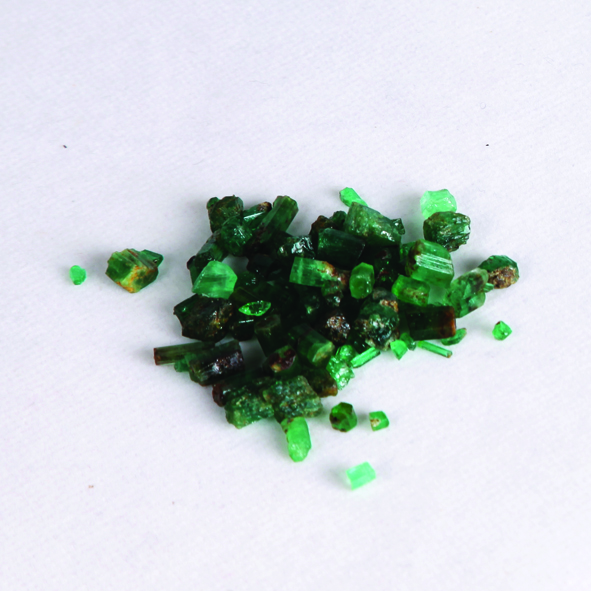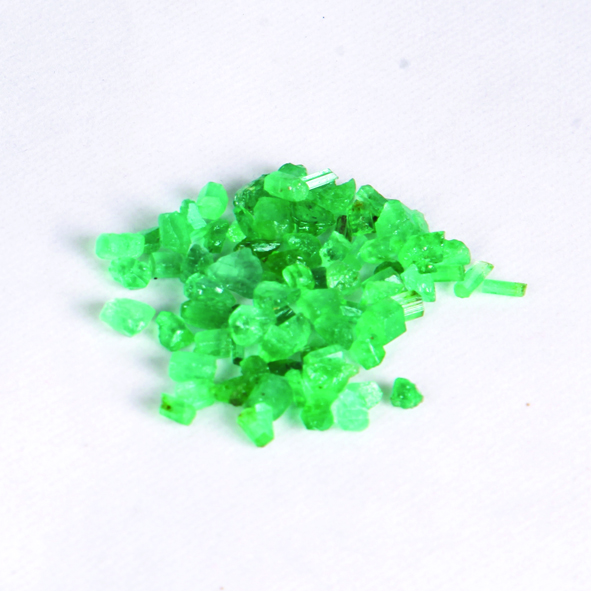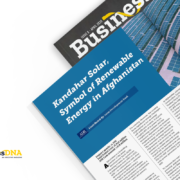By Tania Aria – Founder of Veezha, and
Javed Bakhsh – Gemologist at Sang Laal
BusinessDNA 8th Edition
TRUE TREASURES OF AFGHANISTAN
Afghanistan has been home to more than 120 types of gemstones, mostly colored ones, based on multiple assessment reports. A colored stone is any gemstone other than a diamond. Gemstones are known for their beauty, durability, and rarity. The beauty of a gemstone stems from its color, clarity, luster, cut, and transparency.
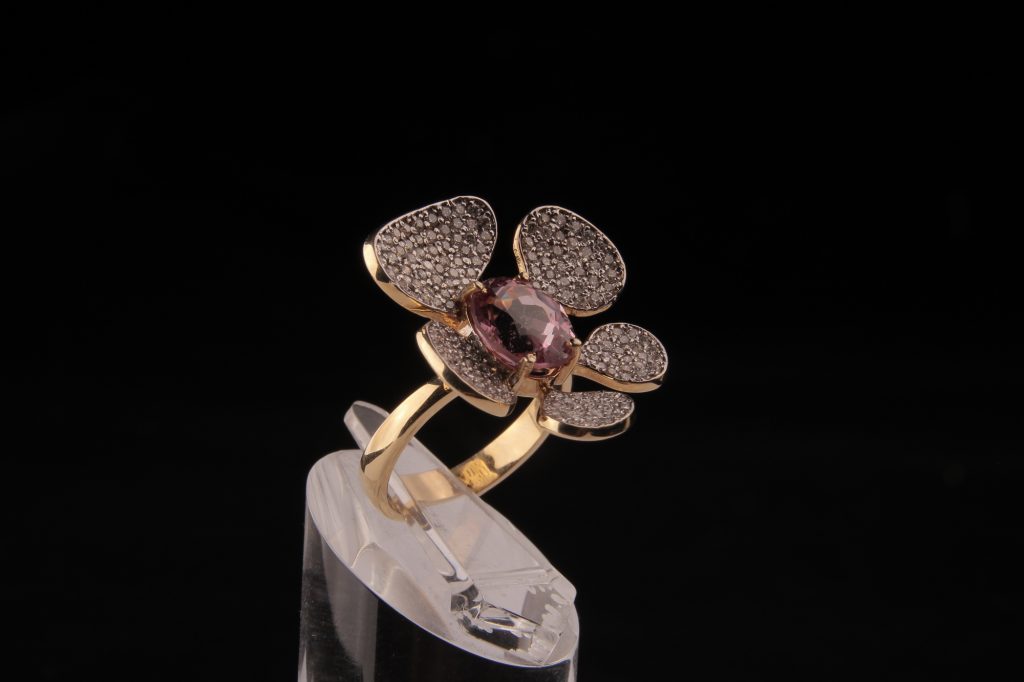
Photo source: BusinessDNA
Each of these has a defining role in the value and price of a gemstone. For instance, a clear emerald with fine color would be more expensive than a low-quality diamond. Read along to learn more about the tiny gems coming from the massive mountains of Afghanistan.

Beyond beauty, a gemstone’s value also comes from its hardness — resistance to scratching — and toughness-resistance to breakage that make it durable over time. Based on Mohs Hardness Scale (1), minerals are categorized by their degree of hardness on a scale of 1 to 10 i.e. Talc has the lowest hardness level of 1 and diamond the highest 10. The colored stones’ hardness range between 5 and 9. For instance, turquoise’s hardness ranges between 5 and 6, whereas ruby and sapphire have a hardness of 9. Hardness is different from toughness, which is defined by a stone’s resistance to breaking, chipping, and cracking.
Jade and nephrite are considered as the toughest stones. Clarity is the other factor in contributing to the beauty of a gemstone. Gemological Institute of America categorizes three clarity types for colored gems:

- Type A gemstones are inclusion-free stones such as aquamarine, citrine, topaz and green tourmaline.
- Type AA gemstones are usually included, such as ruby, sapphire, garnet, peridot, amethyst and spinel.
- Type AAA gemstones are almost always included, such as emerald and red tourmaline. Majority of colored stones are allochromatic, meaning that they are colorless when they are pure. Their color is the result of inclusions of other elements inside the gemstone. Examples include emeralds, rubies, sapphires, spinel, quartz and topaz.
Here we introduce the top colored stones of Afghanistan with their properties and origins:
RUBY & SAPPHIRE
Ruby and sapphire are gems from the mineral corundum — extremely hard crystallized alumina. Both of these gems have the same chemical compositions and mineral structure. Their hardness is 9 in Mohs* hardness scale, qualifying them as the most durable colored stones. The impurities and inclusions in these gems do wonders and determine their color. A brilliant red is known as ruby, and blue and other colors as sapphire.
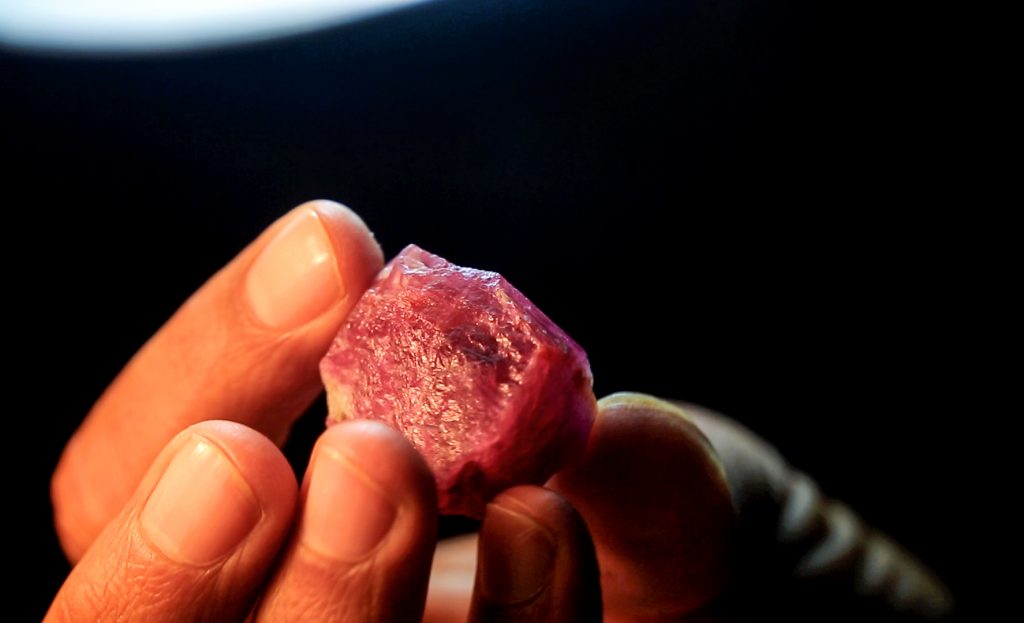
Photo source: BusinessDNA
Afghanistan Ruby mines are found in Jegdalek mines usually formed in marbles as their base mines. Jegdalek mines are located at approximately 60 km east-southeast of Kabul. Research by Gary Bowersox, the experience gemologist and gem hunter shows that about 400 mines are active in this area. Small groups of 5-6 miners or larger groups of 15-20 work the mines, depending on the size of the mines. The study also indicates that 75% of the mines are pink sapphires, 15% ruby, 5% mixed blue to red-pink, and 5% blue sapphire. It is said that these mines have the potential of a year-round mining of rubies and sapphire, which are particularly demanded for high-end jewelry making, given their higher hardness and elegant colors. However, there has not been much done to elevate extracting techniques, processing and value addition of these mines to the current international standards.
SPINEL
Spinel come in different shades including pink, red, lavender, purple, blue and even black. The stone has a hardness of 7.5-8 on the Mohs scale. Spinel is among allochromatic gemstones, naturally colorless when they are pure, and their color stems from the trace of elements inside the gem such as chromium, iron, and cobalt. Afghanistan’s Badakhshan province has been known as the source of spinel, widely recognized in the poetry of some of the great poets in the region. The Afghan spinel is often found in pink and fine red colors.
EMERALD
Emeralds as the iconic colored stones of Afghanistan have a hardness range of 7.5 to 8 on the Mohs scale. Unlike diamonds, which have their own grading system, natural emeralds are considered one of the top precious stones in the world and are valued in a distinctly different way. Emeralds are relatively durable, but the presence of natural inclusions gives each stone a distinct personality and uniqueness that can also affect their toughness. Emeralds are valued by their hue, brilliance, clarity, cut and weight. Certain primary characteristics determine the value of a natural emerald.
Photo source: BusinessDNA
Color: The green hue found in emeralds is the main factor in establishing both their value and quality. The unique green tint is exclusive to natural emeralds not available in other natural gemstones. Hue refers to the exact green color an emerald gemstone displays with a variety of tones. Saturation refers to the degree of darkness in a color.
The most desirable emeralds are medium to dark green allowing an elegant shining polish after a brilliant cut. Usually, emeralds come in very light to light to light medium to dark degrees. Afghanistan has hosted emeralds mines in the Panjshir valley for thousands of years. The emeralds mines—highly inaccessible with difficult routes— are at elevations of approximately 2,135 meters and 4,270 meters in mountainous terrain on the eastern side of the Panjshir River. Panjshir emeralds have different properties from mine to mine. According to gemstone experts familiar with Panshjir, the best emeralds come from Mekini, as they are richer with the bluish green color – a very distinctive property from other emeralds in Panjshir.
Their Commercial value is comparable to Columbian emeralds. In contrast, Emerald crystals from the northern-most mining areas such as Buzmal, Darun, Darilz, and Aryu tend to be lighter. Khers Kanda emeralds are yellowish green to dark bluish green, usually accompanied with white color inclusion in solid crystals with Albite and Mica. Whereas, emeralds from Kamar Safid mine are usually found in lighter green color. The main property of Kamar Safid mine is its perfect luster. Recently, miners have also found samples of emerald in Nooristan and Laghman provinces.
Clarity: Clarity in emeralds is about how the gem looks like on the inside. Most emeralds present inclusions that are small bits of other minerals, gas, liquid, and crystals that the emeralds conceive in the crystallization process. About 99% of natural emeralds present these features. In general, the fewer the inclusions, the higher the value of the gem. Inclusions in emeralds are very special, a natural. Indeed, any emerald without inclusion is immediately suspected as being a synthetic or an imitation.
TOURMALINE
Tourmaline is a popular gemstone around the world, known for its various shades and types. A Tourmaline can easily be tested for clarity with a 10x loupe. Its prices start very low, but can get very expensive, depending on the color and type. Tourmaline has a hardness of 7-5-7 based on the Mohs scale. In recent decades, Afghanistan has become famous for its spectacular tourmalines of different colors and types. Some of the most desirable tourmalines are in Nooristan and Kunar provinces.

Photo source: BusinessDNA
Price: A few very famous types of tourmalines and their properties found in Afghanistan are:

- Chrome Tourmaline: Chrome tourmalines include chromium and vanadium; thus, reveals its vivid green to light blue shades. Chrome tourmaline is actually a distinct green tourmaline variety called chrome dravite, found in eastern Afghanistan. A visibly pure to slightly 5%-15% bluish green gem makes the most stunning color of tourmaline.
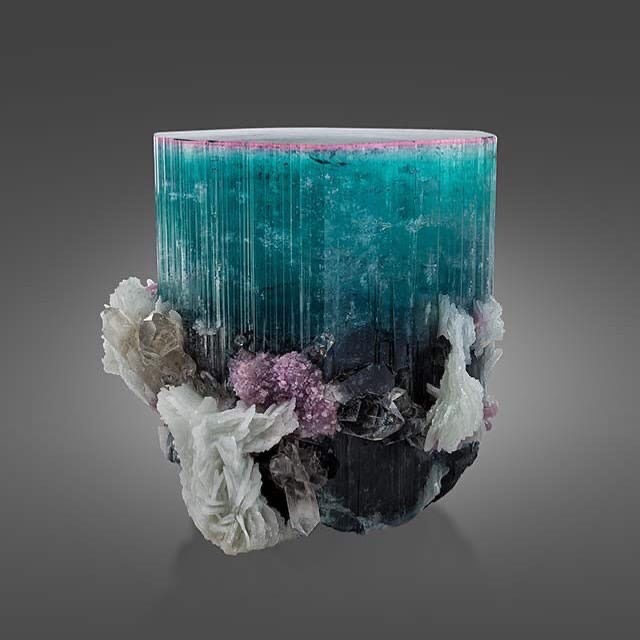
2. Indicolite Tourmaline: The pure blue, with some green hue, makes this type of tourmaline an extremely rare gem. The purer blues are found only in small sizes, often under 1 carat. Larger stones tend to have a stronger green component. Indicolite tourmaline is occasionally found and Afghanistan has been listed as one of the main sources along with Brazil, Nigeria, USA (California and Maine), Mozambique, Namibia and Madagascar.
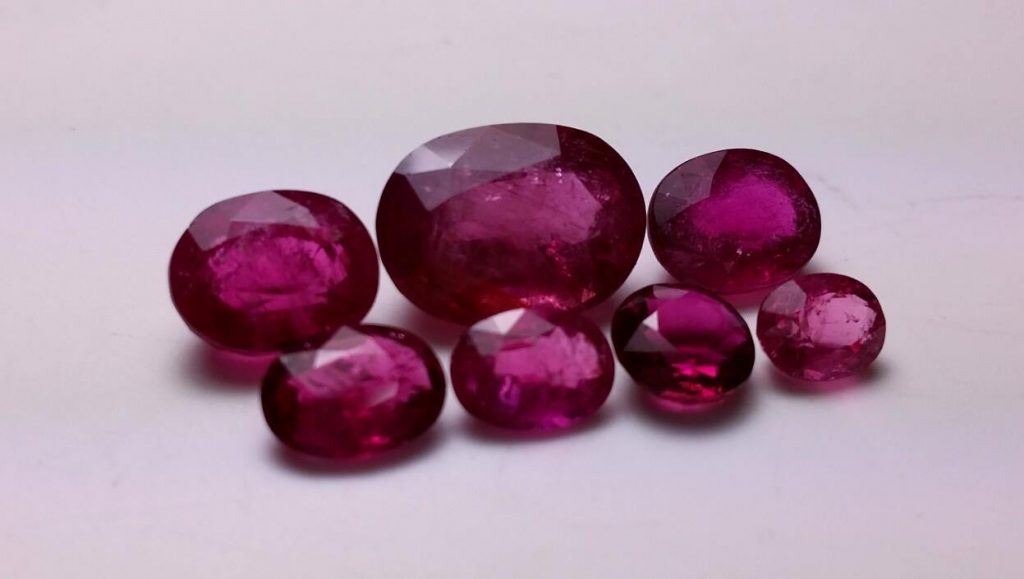
3. Rubellite Tourmaline: These are the family of tourmaline resembling in brilliant-red to a purplish-red. Rubellite’s inclusions and the intensity of its color are the most important consideration in determining its value.

4. Bi-color Tourmaline: Some tourmalines provide a visual record of their crystal growth by displaying two or more areas of different colors. These are known as bi-color tourmalines. Most often, they feature combinations of pink and green or some variation of both. They are also called watermelon tourmaline due to their similarity of colors.
LAPIS LAZULI
Afghanistan is the world’s leading producer of lapis-lazuli from the Sary-Sang area in Badakhshan province. Nine zones have been identified containing ten different lazurite grades, the largest being 250 meter long and extending for 125 meter downdip. The archaeological data indicates mining and trading of this beautiful blue color stone for more than 7000 years. Egyptian burial sites dating before 3000 B.C. contained thousands of Lapis jewelry items.

Photo source: BusinessDNA
Evidence shows the usage of powdered Lapis as a cosmetic eye shadow and in later years as painting pigments by Egyptians. Afghan Lapis also added to the beauty of India’s Taj Mahal Palace. Some lapis include pyrite and calcite and reduces the value. The best lapis mines known in Badakhshan is the Madan 4 with less inclusion and intense blue color. They have been sold up to $5000 per kilo.
AFGHANITE
Afghanite is a rare mineral, with its only significantly important deposit located at Sar-e Sang, Kokcha Valley, in Badakhshan province. This beautiful blue color stone was discovered for the first time in Afghanistan in 1968 and therefore is named after Afghanistan. It forms large and beautiful crystals and are almost always embedded on a white marble. The stone has a hardness of 6-5.5 according Mohs scale and comes in light blue to darker shades.
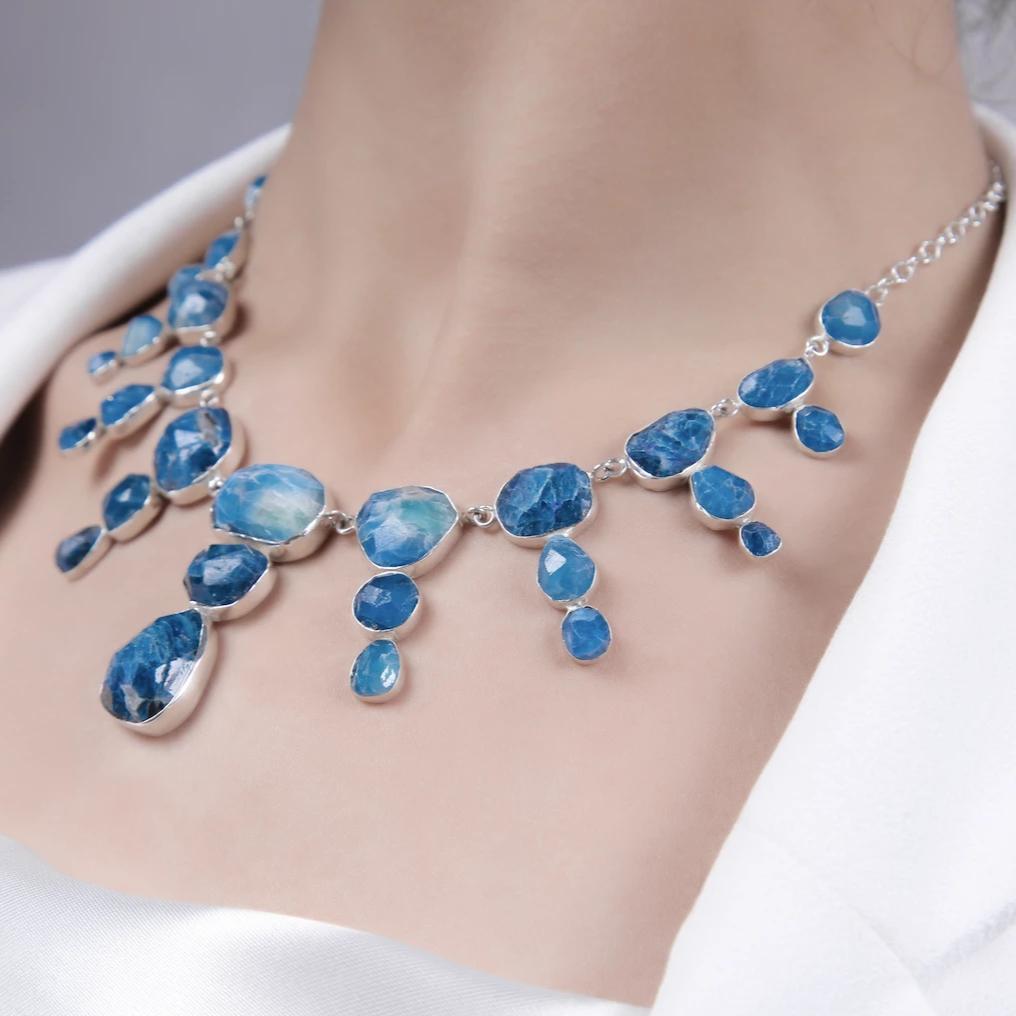
MARKET INFORMATION
Trade map data and Afghanistan National Export Strategy show that Afghanistan has exported gemstones and jewelry from 2005-2015 to 10-21 destinations.
In 2012, the official data of Afghanistan’s gemstone export figures reached $184 million to the global markets.
In 2015, the top export destination was the United States with US$8 million and UAE as the second with US$7 million. France and China are positioned third importers. Other countries such as United Kingdom, Japan, Germany, Australia, India, Canada and Italy have also imported gemstones from Afghanistan, whereas the artisans and other mining experts believe that majority of Afghan gemstones find their way to Pakistan for further value addition.
As part of a series of articles, we will further discuss the commercial and business aspects of Afghanistan gemstones and jewelry in the upcoming editions of BusinessDNA. ■



